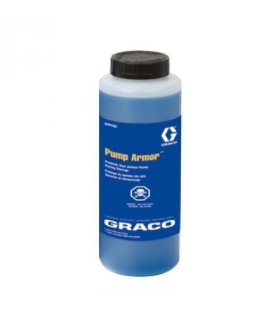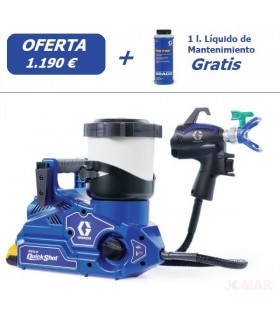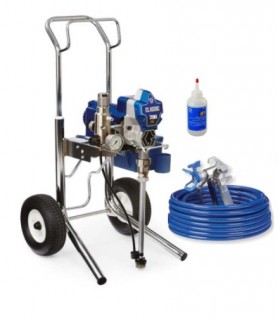Reversible Tip Airless FFLP - GRACO Low Pressure - FFLP Rac X
✔ Boquilla Airless Reversible Original GRACO FFLP EL MEJOR ACABADO CON LA MINIMA PRESION DE TRABAJO , con la GarantIa del Servicio Oficial
✔ Producto con PRECIO CANTIDAD , elige cualquier paso o modelo de boquillas RAC X - RAC V - XHD.
Although it is only a small part of your sprayer, the nozzle is of great importance.
We will explain briefly and concisely why this is so.
What is a nozzle used for?
Airless sprayers push paint at high pressure (up to 350 bar) through the small orifice of the nozzle. The nozzle tells the pump how hard it must work to maintain the required pressure. The nozzle ensures that the paint is atomized according to a given fan width and flow rate: an effect similar to putting your thumb on the end of a garden hose.
Why is it so important to choose the right mouthpiece?
A proper nozzle ensures less overspray and therefore better control and finish. Not only will less paint be used, but it will also take less time to complete the job
A suitable nozzle:
- Increases your performance
- Improve the quality of your work
- Keeps your budget in check
Why are there so many nozzles and so many different sizes of nozzles in
A simple comparison would be choosing the right drill bit for a drill.
There are drills specifically designed for wood, while others are designed for metal or concrete. In addition, all drills are available in several different sizes.
Using the wrong bit on the wrong surface will not produce the desired results. This also applies to airless nozzles.
Not all nozzles are the same. And there's a good reason for that. Find out how to tell the difference between nozzles below
EXAMPLE... BLUE NOZZLE OF
-
The color indicates the application for which the nozzle can be used
There are four types of nozzles for RAC X nozzles, which are used the Blue RAC X nozzle head 246215, the RAC V nozzle with Orange nozzle holder 243161 with 7/8 thread or 243263 with 11/16 thread (Wagner, wiwa,... guns) and gray XHD nozzles with gray XHD nozzle holder, each one is used for a specific application.
Each type of nozzle is assigned its own color, which makes it easy to distinguish between them.
FFLP AND LP ( GREEN ).. Guarantees the best possible finish at low pressure for high finish applications and wall paints. Interior paint jobs and residential projects
PAA ( BLUE ) For wall painting, it is compatible with general paint spraying. Interior and exterior painting jobs in homes and industrial or commercial projects
HDA ( BROWN ) For diluted plasters and less fluid products, intumescent type, putties. Interior and exterior painting works with airless plastering and high production applications
LL5 ( YELLOW )For road marking Parking spaces, roads, warehouse floors, crosswalks and sports courts
RAC V ( BLACK )Graco universal nozzle, compatible for all uses.
XHD ( GRAY )500 bars nozzle, for industry, available in all steps.
-
The first number indicates the width of the nozzle fan (EXAMPLE NOZZLE 517)
The first digit ( 5 ) represents the spray distribution width (the fan width) and corresponds to the spray angle.
If the number is "5", then spraying is performed at an angle of 50°. Multiplying this number by five gives the width of the fan when the spray gun is held 30 cm away from the surface.5 × 5 = 25 cm (fan width)
- The last two numbers indicate the spray orifice of the nozzle
The last two digits of the nozzle ( 17 ) designate the size of the spray orifice in thousandths of an inch. The higher the number, the greater the flow rate that can be sprayed.
Thus, for example, a "517" nozzle will accept a higher flow rate than a "515" nozzle. "17" refers to a 0.017 in (0.43 mm) orifice

The choice of the correct nozzle is made in three steps. First, it is necessary to determine in which application the nozzle will be used (i.e. which product is to be sprayed) and then the required fan width and flow rate
STEP 1
In which application will you use the nozzle?
Each nozzle has been developed for a specific application. High-finish products (e.g. stains or varnishes) require a nozzle with a smaller orifice. On the other hand, heavier products (such as plastic paint) require a larger orifice. Depending on the nozzle color, you will immediately know which nozzle is best suited for your application.

STEP 2
What is the desired fan width?
The fan width is determined by the angle when spraying at a distance of 30 cm from the surface. The wider the spray distribution, the faster large surfaces will be painted, although paint consumption will also be higher. With a smaller distribution, you work slower, but the paint consumption is lower and the control increases. Calculate the desired fan width and divide that figure by 5. The value obtained will tell you what the first number of your nozzle should be.
For example, if the fan width is 25 cm, then the first digit of the number should be 5 (= 5 × 5). The number 5 corresponds to a spray angle of 50°. On the other hand, if a fan width of 35 cm is desired, then the first digit must be a 7 (7 × 5 = 35). The angle in this case is 70°.
STEP 3
What is the maximum flow rate of the sprayer?
The size of the nozzle orifice determines the amount of paint it sprays. The maximum flow rate of the sprayer should always be greater than the nozzle flow rate. The actual flow rate depends on the spraying pressure and the type of paint used: higher pressures produce a higher flow rate, while heavier types of paint reduce the flow rate.
From the table below, choose your nozzle flow rate and check if it is appropriate for your equipment. Never use a nozzle size larger than your equipment can handle. The sprayer must be able to pump at a minimum flow rate.

The following list will help you choose the right nozzle for each specific application and product.
Ask our technical department for theadvice on which nozzle is best suited to your situation, as well as for more information on all nozzle sizes available in each series.
The nozzle steps are detailed according to the application .
- High-finish paints for brush and roller 008 - 010
- Varnish 010 - 014
- Dye 012 - 014
- Oil paints : Polyurethanes 012 - 014
- Plastic paint 015 - 019
- Acrylic paint 015 - 019
- Silicate paints 015 - 019
- Emulsions 017 - 021
- Silicone 021 - 025
- Multicolor 023 - 025
- Wall plasters 023 - 025
- High production projects 025 - 031
- Wall plasters 027 - 031
- Intumescent products 029 - 035
- Airless plasters 029 - 041
- Elastomers 027 - 033
- Putties 041 - 047
- Epoxies 043 - 061
- Asphalt with fibers 047 - 053
- Asphalt 031 - 071
- Silicate/mineral 027 - 033
- Airless signage paint 013 - 019

























